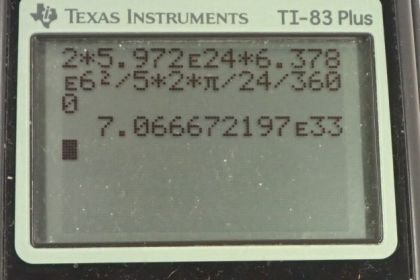Question
(a) Calculate the angular momentum of the Earth in its orbit around the Sun.
(b) Compare this angular momentum with the angular momentum of Earth on its axis.
Final Answer
Solution video
OpenStax College Physics for AP® Courses, Chapter 10, Problem 36 (Problems & Exercises)

vote with a rating of
votes with an average rating of
.
Calculator Screenshots
Video Transcript
This is College Physics Answers with Shaun Dychko. To start this question, I looked up on Google some information about the Earth and here's its mass—5.972 times 10 to the 24 kilograms; its orbital radius, distance between the Earth and the Sun is 1.496 times 10 to the 11 meters and the radius of the Earth, assuming it's a sphere, is 6.378 times 10 to the 6 meters. So the angular momentum that it has in its orbit is its moment of inertia multiplied by its angular velocity and it's a point mass so its moment of inertia is gonna be mass times its orbital radius squared. So that's 5.972 times 10 to the 24 kilograms times its orbital radius squared times its angular velocity, which is 2π radians which is one full circle in one year which is 365.25 days and then convert the days in the denominator into seconds by multiplying by 1 day for every 24 hours and then by 1 hour for every 3600 seconds and we end up with 2.66 times 10 to the 40 kilogram meters per second. The angular momentum of its rotation is going to be this moment of inertia which we found using our handy table of formulas. The Earth is a solid sphere and its formula is 2mr squared over 5 so we multiply that by its angular velocity of rotation. So that's 2 times the Earth's mass times the radius of the Earth squared divided by 5 times a full circle—2π radians— in one day which is 24 hours times 1 hour for every 3600 seconds and we end up with 7.07 times 10 to the 33 kilogram meters per second. Now comparing the orbital angular momentum with the rotational angular momentum means we divide these two answers and we find that the orbital angular momentum is greater than the rotational angular momentum by a factor of 3.77 times 10 to the 6.


